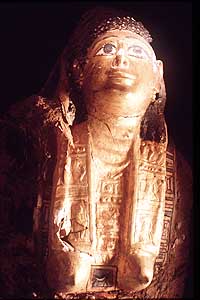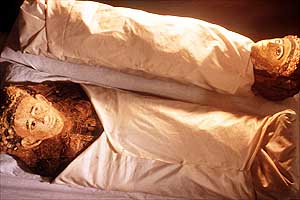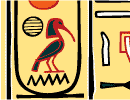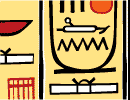The New York Times -- August 24, 1999
In the 'Valley of the Mummies,' Revelations of a Golden
Past
By JOHN NOBLE WILFORD
 t
an oasis 230 miles southwest of Cairo, people in Roman times lived
well on the wealth they accumulated making wine from dates and grapes.
And in death, their bodies were prepared well for the afterlife,
mummified and fitted with elaborate masks and waistcoats covered in
gold.
t
an oasis 230 miles southwest of Cairo, people in Roman times lived
well on the wealth they accumulated making wine from dates and grapes.
And in death, their bodies were prepared well for the afterlife,
mummified and fitted with elaborate masks and waistcoats covered in
gold.
|

Philippe Plailly/Eurelios
|
The mummy of a woman, covered in
gilded mask, whose gaze is directed at the mummy of her husband.
Her hairstyle is Roman, but clothes are Egyptian.
|
A vivid
record of affluence, art and religion in Roman Egypt has been
preserved in a large 2,000-year-old cemetery at the Bahariya Oasis,
which came to light three years ago -- literally by accident. A donkey
being ridden on a dusty road stumbled, and its leg slipped into an
opening to one of the many tombs buried there under sand and rock.
After intensive excavations this year, Egyptian archeologists have
disclosed the first details of what they say is one of the most
spectacular discoveries in Egypt in recent decades. Detailed
pictures of the tombs and mummies are being published this week in
Archaeology, the magazine of the Archaeological Institute of America.
"Never before have such a number of mummies been found in a single
site in Egypt," Dr. Zahi Hawass, director of the Bahariya
excavations, said in an interview last week. He is Egypt's
Under Secretary of State for the Giza monuments, the pyramids near
Cairo.
In the four tombs so far explored, archeologists counted 105
mummies of men, women and children. Entire families appeared to be
together in repose. Some of the bodies were wrapped in plain linen,
but many were decorated with gilded masks and painted scenes on
cartonage, which is the pasteboard made of linen and papyrus that
served as mummy cases. No two mummy decorations were alike.
Dr. Hawass said the cemetery site included many more multichambered
tombs and extended over more than two square miles. He estimated that
as many as 10,000 mummies might be uncovered at what is being called
the Valley of the Golden Mummies.
Writing in Archaeology, Dr. Hawass described his first impressions
of the rows of mummies, many of them surrounded by pottery, amulets
and other grave goods. "I could not believe that such beautiful
specimens existed," he said. "The eyes of some gazed at me as if they
were alive."
His own eyes were drawn to the mummy of a woman, about five feet
tall, adorned with a crown with four decorative rows of red curls and
a gilded mask that extended over the chest to two circular disks
representing breasts. The decorations incorporated images of cobras
and the children of gods.
"While the hairstyle was clearly Roman, reminiscent of terra cotta
statues of the period," Dr. Hawass wrote, "the iconography of her
mask, painted with deities that protected the deceased and ease her
passage into the afterlife, was pure Egyptian."
The team of archeologists said the mummies were remarkably well
preserved, with the smell of embalming resin still strong in the
tombs. But it appeared that the Romanized Egyptians applied less
effort on preparing the mummified body itself and more on exterior
decorations. The discovery provided new evidence that funerary
practices from the last thousand or so years of the pharaohs had
continued well into the second century A.D. The Roman rule of
Egypt began shortly before the birth of Christ.
The art of mummy paintings, masks and other decorations in Roman
Egypt has been familiar to scholars for more than a century. In
1888, the British archeologist William Flinders Petrie found gilded
masks at a Roman-period cemetery. "Ancient Faces: Mummy
Portraits from Roman Egypt," a recent book published by the
British Museum in London, described the practice as being "derived
from pharaonic traditions of belief, in which the mask served as a
substitute for the head of the deceased, endowing the individual with
the attributes of deities and thereby assisting his or her passage to
the afterlife."
|

Philippe Plailly/Eurelios
|
The mummies of a young boy and
girl, believed to be from the same family.
|
But
Egyptologists and other scholars said the new find promised to yield
important insights into the lives of affluent Romanized Egyptians,
their religious beliefs and funerary traditions.
"It's going to be very exciting," Dr. Roger Bagnall, a classics
professor at Columbia University who specializes in Egypt's
Roman period, said of the prospects for gaining a better understanding
of Egyptian culture.
As beautiful and interesting as the gilded artifacts were, Dr.
Bagnall said, he was more impressed by the sheer size and condition of
the site.
"This may be the largest known cemetery in Egypt that hasn't
been gotten to by plunderers before the archeologists," he said.
Even the most celebrated Egyptian discoveries of this century --
the tomb of King Tutankhamen, opened in the 1920's, and the tomb of
the many sons of Ramses II, still being excavated -- were not pristine
sites. Looters had left their destructive marks and made off with some
of the artifacts. But no one seems to have touched the new-found
Bahariya tombs, and no modern community has risen on the site to get
in the way of excavations. For now, the tombs are closed to the public
and under guard.
Using new tools for pathological examinations, scientists should be
able to study the mummy skeletons for information on what the people
ate, the diseases they suffered and the causes of their deaths.
The large number of mummies should provide better demographic data,
including estimates on infant and child mortality and life expectancy.
The architecture of the Bahariya tombs also intrigued scholars. Dr.
Hawass said the four explored tombs, cut into sandstone bedrock, have
somewhat distinctive styles, but have similar passages and chambers.
The entrance of a typical tomb was a hall about eight feet long. This
led to a "room of handing-over," where the family would have delivered
the mummy for transfer from the world of the living to that of the
dead.
Beyond that were the burial chambers carved from sandstone.
The tombs generally had two chambers, each with several smaller
rooms where the mummies were laid out. One tomb had catacomblike
burial rooms, one above the other.
The entrance to one tomb was flanked by images of Anubis, the god
of embalming. Dr. Hawass said it was the first time he had seen this.
Though the mummies date to the first and second centuries A.D., Dr.
Hawass said the site was probably a burial place from the time
Alexander the Great was in Egypt, in 322 B.C. A Hellenistic
temple stands near the cemetery.
Egyptian archeologists described four general types of mummies
found at Bahariya. About 60 mummies excavated so far wear the gilded
masks. A second type is characterized by the head-to-waist cartonage,
which depicts scenes of various gods such as Isis, Osiris and Toth,
who sat in judgment of the deceased. A third type of mummy has no
decoration but is resting in a human-shaped pottery coffin. Another
type is covered entirely in linen, much as the mummies were in the
time of the pharaohs.
Dr. Bagnall of Columbia looked forward to comparing the new
discoveries with the mummies French archeologists have excavated in
recent decades at Douch, a former Roman military post 120 miles west
of Luxor on the Nile River. The funerary practices seem to be similar,
he said, but the Bahareya cemetery apparently holds a much richer
treasure of mummies.
Egyptian archeologists plan to resume excavations there in
November. It may take them a decade to explore the entire cemetery and
assemble a clear picture of how the affluent classes of Roman
Egypt lived and died.
Related Sites
These sites are not part of The
New York Times on the Web, and The Times has no control over their
content or availability.





